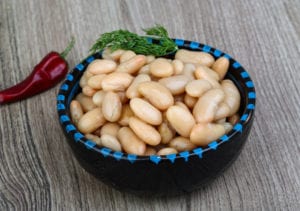Written by Taylor Woosley, Staff Writer. Multivariate analysis shows that systolic and diastolic blood pressure values were significantly and inversely associated with legume consumption (p < 0.001; p = 0.014, respectively).
 Hypertension and diabetes mellitus are leading causes of cardiovascular disease1. Hypertension occurs in 50% to 80% of people with type 2 diabetes (T2D), who make up over 90% of the diabetic population2. In individuals with T2D and hypertension, microvascular and macrovascular complications are significantly more common than in those without hypertension3.
Hypertension and diabetes mellitus are leading causes of cardiovascular disease1. Hypertension occurs in 50% to 80% of people with type 2 diabetes (T2D), who make up over 90% of the diabetic population2. In individuals with T2D and hypertension, microvascular and macrovascular complications are significantly more common than in those without hypertension3.
Strong evidence demonstrates that dietary patterns associated with decreased risk of cardiovascular disease are characterized by higher consumption of vegetables, fruits, and whole grains, and lower consumption of processed meat and sugar-sweetened foods4. Certain plant foods such as legumes are rich in vitamins, minerals, antioxidants, unsaturated fatty acids, and dietary fiber5. Furthermore, legume consumption has been associated with significant blood pressure-lowering effects, such as vasodilation, owing to their high arginine content6.
Vitale et al. conducted a cross-sectional study to analyze the association between habitual legume consumption and systolic and diastolic blood pressure control using data from the TOSCA.IT trial. The TOSCA.IT study was a randomized clinical trial aimed to evaluate the use of two different hypoglycemic drugs on cardiovascular effects. From the original trial, 1897 subjects with diagnosed hypertension and available dietary data were included in the cross-sectional analysis.
Participant data collected at baseline, including anthropometric measures and fasting blood samples, were included in the analysis. Blood samples were utilized to measure HbA1c and lipid profiles, and blood pressure was also measured. A food frequency questionnaire (FFQ) was completed by participants to assess dietary habits during the past 12 months. The USDA and Phenol-Explorer databases were utilized to obtain polyphenol intake. Multivariate linear regression analysis was used to estimate the separate and combined association of legumes with systolic and diastolic blood pressure and to explore the role of nutrients from legumes on systolic and diastolic blood pressure.
1079 men (56.9%) and 818 women (43.1%) with a history of T2D for 8.7 years (± 5.7 years) and hypertension of 7.2 years (± 6.4 years) were included in the final analysis. Mean age was 62.8 years (±6.4 years) and BMI 30.8 ± 4.5 kg/m2. Most participants were taking anti-hypertensive medications (95.6%) and 22% of subjects had micro-albuminuria. Significant findings of the study are as follows:
- The highest quartile of legume consumption (Q4) experienced significantly lower levels of systolic and diastolic blood pressure compared to the lowest quartile (Q1) (132.9 ±7 vs. 137.3 ± 7.0 mmHg, p < 0.001; 78.9 ± 4.1 vs. 81.0 ± 4.2 mmHg, p = 0.002; respectively).
- Participants with the highest legume consumption (Q4) had significantly lower intake of total carbohydrates, glycemic load, alcohol, and sodium (p < 0.001). Additionally, a significantly greater intake of total proteins, especially plant protein, total fat, fiber, potassium, and polyphenols, were associated with higher legume intake (p < 0.05).
- Multivariate analysis shows that systolic and diastolic blood pressure values were significantly and inversely associated with legume consumption (β = -0.087, p < 0.001; β = 0.061, p = 0.014, respectively).
Results of the study show that habitual legume intake was associated with lower levels of diastolic and systolic blood pressure in subjects with T2D and hypertension. Legume intake was found to be most beneficial at approximately three servings per week. Study limitations include the inability to establish a cause-effect relationship due to the cross-sectional study design, the lack of analyzing different types of legumes consumed, and the potential effect of residual confounding factors.
Source: Vitale, Marilena, Annalisa Giosuè, Sabina Sieri, Vittorio Krogh, Elena Massimino, Angela Albarosa Rivellese, Gabriele Riccardi, Olga Vaccaro, and Maria Masulli. “Legume Consumption and Blood Pressure Control in Individuals with Type 2 Diabetes and Hypertension: Cross-Sectional Findings from the TOSCA. IT Study.” Nutrients 15, no. 13 (2023): 2895.
© 2023 by the authors. Licensee MDPI, Basel, Switzerland. This article is an open access article distributed under the terms and conditions of the Creative Commons Attribution (CC BY) license (https://creativecommons.org/licenses/by/4.0/).
Click here to read the full text study.
Posted August 8, 2023.
Taylor Woosley studied biology at Purdue University before becoming a 2016 graduate of Columbia College Chicago with a major in Writing. She currently resides in Glen Ellyn, IL.
References:
- Simões Corrêa Galendi J, Leite R, Banzato LR, Nunes-Nogueira VDS. Effectiveness of Strategies for Nutritional Therapy for Patients with Type 2 Diabetes and/or Hypertension in Primary Care: A Systematic Review and Meta-Analysis. Int J Environ Res Public Health. Apr 2 2022;19(7)doi:10.3390/ijerph19074243
- Jia G, Sowers JR. Hypertension in Diabetes: An Update of Basic Mechanisms and Clinical Disease. Hypertension. Nov 2021;78(5):1197-1205. doi:10.1161/hypertensionaha.121.17981
- Przezak A, Bielka W, Pawlik A. Hypertension and Type 2 Diabetes-The Novel Treatment Possibilities. Int J Mol Sci. Jun 10 2022;23(12)doi:10.3390/ijms23126500
- Committee DGA. Dietary Patterns and Risk of Cardiovascular Disease: A Systematic Review. 2020.
- Zhu R, Fogelholm M, Poppitt SD, et al. Adherence to a Plant-Based Diet and Consumption of Specific Plant Foods-Associations with 3-Year Weight-Loss Maintenance and Cardiometabolic Risk Factors: A Secondary Analysis of the PREVIEW Intervention Study. Nutrients. Nov 1 2021;13(11)doi:10.3390/nu13113916
- Reyneke GL, Beck EJ, Lambert K, Neale EP. The Effect of Non-Oil Seed Legume Intake on Blood Pressure: A Systematic Review and Meta-Analysis of Randomized Controlled Trials. Advances in nutrition (Bethesda, Md). Jul 2023;14(4):637-651. doi:10.1016/j.advnut.2023.04.002
